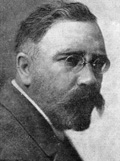| Born in a Jewish family, Lev Rozenfel'd (Kamenev) became a professional revolutionary, joining the Russian Social-Democratic Workers' Party (RSDRP) in 1901. In 1908 he emigrated to western Europe, where he worked closely with the Bolsheviks, headed by Vladimir Ul'janov (Lenin). After a three-year exile in Siberia, he returned to Petrograd and was elected to the party Central Committee as full member (Apr/May 1917 - 4/17 Nov 1917]. On 10/23 Oct 1917 he was also elected to the Political Bureau of the RSDRP, but he opposed the idea of violent seizure of the state power. Despite this grave confrontation with Lenin, Kamenev was elected the first nominal head of the Soviet Russia as chairman of the All-Russian Central Executive Committee (27 Oct/9 Nov 1917). However, soon Kamenev resigned from the Bolshevik Central Committee (4/17 Nov 1917) as he supported the government including various political parties rather than only the Bolsheviks as Lenin suggested. On 8/21 Nov 1917 Kamenev resigned as chairman of the All-Russian Central Executive Committee. In 1918-1926, Kamenev served as chairman of the Moscow Soviet (municipal council). The 8th party congress again elected him full member of the Central Committee (Mar 1919 - 14 Nov 1927). Also, Kamenev became full member of the Politburo (25 Mar 1919 - 18 Dec 1925). On 14 Sep 1922, Kamenev joined Aleksej Rykov and Aleksandr Cjurupa as one of the deputy chairmen of the RSFSR Council of People's Commissars and the Council of Labor and Defense. On formation of the first government of the USSR, Kamenev was made first deputy chairman (6 Jul 1923 - 16 Jan 1926) and later succeeded Lenin as chairman of the Council of Labor and Defense of the USSR (2 Feb 1924 - 19 Jan 1926). The "triumvirate" of Zinov'ev, Kamenev, and Stalin assumed the control over the nation after Lenin's death, but Zinov'ev and Kamenev soon found their positions being undermined by Stalin, and they went over to a "Left" stance. The fall of Kamenev began in 1925, when the 14th party congress condemned him as a member of a "New Opposition" and demoted to candidate membership in the Politburo (1 Jan 1926 - 23 Oct 1926). He was removed from key positions in the Soviet government and was appointed people's commissar for internal and external trade of the USSR (16 Jan 1926 - 14 Aug 1926). Then he was sent to Italy as ambassador (1926-1927). The joint plenum of the Central Committee and the Central Control Commission expelled him from the Politburo (23 Oct 1926). Kamenev returned to Russia in 1927 to find that the Central Committee excluded him from its ranks (14 Nov 1927). The 15th party congress (Dec 1927) cracked down on the Zinovyevites and the Trotskyites and expelled Kamenev and thousands of their supporters from the party. In 1927-1929, Kamenev headed the scientific department of the All-Union Council of People's Economy and was readmitted to the party on 22 Jun 1928. In 1929-1932, he was a chairman of the Main Department for Industrial Concessions. In October 1932, Kamenev was tried for involvement in the Marxist-Leninist Association. For the second time, he was expelled from the party on 9 Oct 1932, and sentenced to exile to Minusinsk. In December 1933 Kamenev was released and returned to Moscow. The Central Control Commission restored his party membership on 14 Dec 1933. He received a job as director of the Academia publishing house, and then as director of the World Literature Institute. After the party leader Sergey Kirov was assassinated, Kamenev was arrested on 16 Dec 1934, and ultimately expelled from the party on 20 Dec 1934. Sentenced on 16 Jan 1935, in the Zinovyevite "Moscow center" case to imprisonment for five years and again on 27 Jul 1935, to imprisonment for ten years, Kamenev served his term in Chelyabinsk. In August 1936, however, he and Zinovyev were tried again in the first public-show trial of the Great Purge. Accused of conspiring to assassinate Stalin and other Soviet leaders, Kamenev confessed to the fabricated charges and was sentenced to death on 24 Aug 1936. |
| [1] |
Протоколы засѣданiй Всероссiйскаго Центральнаго Исполн. Комитета Совѣтов Р., С., Кр. и Каз. Депутатов II созыва. М: Издат. Всероссiйскаго Центральнаго Исполнительнаго Комитетов Совѣтов Р., С., К. и К. Депутатов, 1918, с. 4. |
| [2] |
Протоколы засѣданiй Всероссiйскаго Центральнаго Исполн. Комитета Совѣтов Р., С., Кр. и Каз. Депутатов II созыва. М: Издат. Всероссiйскаго Центральнаго Исполнительнаго Комитетов Совѣтов Р., С., К. и К. Депутатов, 1918, с. 40. |

